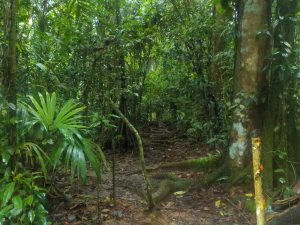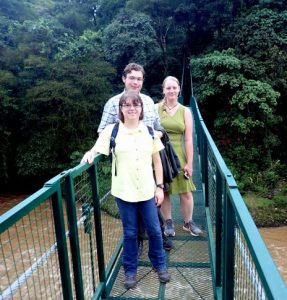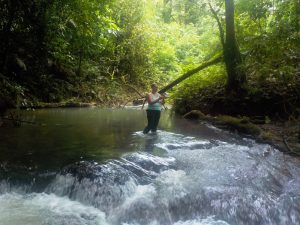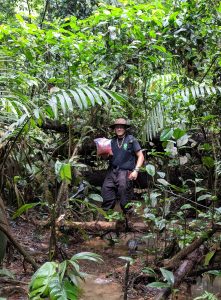When students tell you they spent their summer conducting research amidst strawberry poison arrow frogs, sloths, Capuchin monkeys, great curassows (a bird), terciopelo (a venomous viper) and caimans, and you guessed they weren’t in Missouri, you would be correct.
In fact, they were more than 3,000 miles from home in a tropical rainforest in northeastern Costa Rica.
Chris Watson, Rebecca Prest and Dr. Carissa Ganong, assistant professor of biology, spent nine weeks at the La Selva Biological Station conducting research related to stream ecology.
Dr. Ganong has been conducting research at the station, which she calls “a premier tropical research station,” off and on for more than 13 years, including researching there when she was an undergraduate and doctoral student. For the past five years, she has coordinated National Science Foundation Research Experiences there for undergraduate students.
Watson, a biochemistry and molecular biology major from Platte City, Missouri, studied the effect of high levels of pH on the growth rates and survival of aquatic midge larvae.
Prest, a biochemistry and molecular biology major with an American Chemical Society certification, conducted research on the effects of a pesticide on two insect and one fish species in the rainforest streams. She was funded by an Emerging Challenge in Tropical Science pilot grant through the Organization for Tropical Studies that was awarded to Dr. Ganong,
“I spent a lot of time in the streams and running lab trials,” Prest said.
Their team consisted of 18 undergraduate students from across the globe, and Prest said she enjoyed talking to everyone about their research projects.
Watson’s field work took him several miles from the station, “hiking, biking and sliding” through lots of brush and streams, and getting “stuck in the mud more times than I can count.” Prest’s field work was held up for two weeks because of rains.
“It was a bit intense, but I loved every minute of it,” Watson said. “The entire experience was truly remarkable.”
The students plan to present on their research projects at the National Society for Freshwater Science conference this coming May in Utah.
“One of the most deeply satisfying parts of mentoring tropical research is seeing and helping students transform from ‘jungle newbies’ into experienced, confident field researchers,” Dr. Ganong said. “And along the way, they made new friends, discovered the wonders of the rainforest ecosystem, learned about different cultures and ways of life, and had unforgettable adventures. Hopefully, the lessons and memories of this summer will stand out in the students’ minds for years to come.”
Blogging from a Tropical Rainforest
Check out the blog posts of Dr. Carissa Ganong, Chris Watson and Rebecca Prest at mwsulaselva2018.wordpress.com/page/1. Below are some excerpts from it:
Typing from a very rainy La Selva. This was our second day of prep work for research, which involved a 3 km hike. – Chris
Quick update from an unusually warm and mosquito-y La Selva. After last week’s pilot fieldwork, all 18 students gave formal proposal presentations. Chris and Rebecca’s presentations were excellent! – Dr. Ganong
I need to do an official tally at some point, but I am certain that I’ve exceeded 100 unique species that I’ve observed, and that’s only counting the animals. Everywhere you look, every rock, every leaf, every branch; life abounds in every way, shape and form. – Chris
Research is progressing nicely, but time is flying! I’ve seen all of the large ground bird species. The curassows are still my favorite because they both look and act like mentally disturbed dinosaurs. While collecting caddisflies at one of my field sites, Dr. Ganong and I were harassed by a pair of very noisy and nosy toucans. – Rebecca
Jill Leonard from Northern Michigan University enjoyed working with Rebecca in the field and lab, and dubbed Rebecca the “Guppy Queen” for her skill at hand-netting small fish. – Dr. Ganong
This turnip-tailed gecko caught and ate a katydid right outside my window. It’s extremely easy to get distracted from your work here for exactly that reason; there’s too many cool things to watch. – Rebecca
Rebecca and I completed the perimeter hike of La Selva yesterday, a distance of roughly 10 miles. The hike took a little over nine hours, because of mud, numerous stream/river crossings and steep hillsides. There was a plethora of beautiful scenes and I added eight vertebrate species to my list, bringing my total for vertebrate species observed to 168. – Chris
I really need to learn that in order to take good quality pictures in the rainforest you must check your camera lens for condensation every. single. time. you want to take a picture. Or else you end up with foggy pictures. – Rebecca
So far, the rainforest has taken my umbrella, my watch, one of my flashlights, several space pens, and most of the functionality of my mud boots. My field pack smells like a peccary (pig-like mammal). But it’s all worth it. I can honestly say that this has been the best summer of my life. I have learned so much about the world around me, being a researcher, and about myself.
–Rebecca



